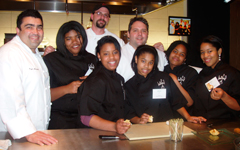Musings and Marvels from Brainfood's Urban Kitchen Garden
I get to witness the growth of a kale plant from seed to plate approximately 60 times each growing season in the Brainfood Youth Garden. And when you consider the hundreds of plants that I watch grow through a full life cycle each year, it would make sense to assume that germination/flowering/fruiting/death/compost is just the day-to-day work schedule. And it is.
But dang! Even as an expected part of my everyday work life, I can’t help but marvel at the tiny leaves still clinging to their split seed as they grow towards the sun. Or the three-foot beast of a kale stem that I throw into my compost bin at the end of summer. It kind of looks like its covered in dragon skin, the scales of which are actually scars where the plant healed itself after each leaf I harvested.
I find this kind of everyday marveling really adds depth to my appreciation of each meal I consume. And further, it hugely expands my understanding of the complex network of efforts on the part of nature and humans to cultivate our modern food system. This fall, I have been lucky to lead Brainfood’s efforts to integrate seed-to-plate concepts into our cooking programs and community outreach events so that our students and volunteers also get to participate in the full loop of grower-to-consumer that is behind each ingredient we use in class. I think these pictures speak to the multitude of marveling that has ocurred in our first month of programs.
October 24th was Food Day, a day celebrated across the nation as a means of raising awareness about healthy, affordable, and sustainable food. The Kitchen All-Stars' visit to the garden coincided with Food Day and sparked a great brainstorm about how we address the type of food system changes that Food Day advocates every day in class. Examples our students pointed out include:
- as part of our curriculum, we learn about healthy subsititions for baking recipes
- much of the produce we use in class is grown nearby in our own organic garden - we know our grower, our food doesn't have far to travel, and therefore we are supporting a healthy, more sustainable food system by relying on local produce for many of our recipes
- we compost our food scraps, fueling healthy soil for our garden
- we are learning to cook, which means we are learning to create food that maybe we otherwise would have to buy from a restaurant that may not use healthier practices or techniques that we learn
There's a lot more to unpack about how our work as Brainfoodians adresses these broad Food Day themes, and I look forward to sharing that information in future blogposts as we move forward through programs. As a follow-up to such great discussions in class, we cooked carrot cake cupcakes and garden greenies (an heirloom recipe honed by one of our staffer's grandmother!). Think cheesy vegetable bread. Both recipes were successful in demonstrating the awesome power of garden vegetables to create student-approved snacks.
For our Kitchen All Stars based at our Columbia Heights site, a visit to the Brainfood Youth Garden next to Mt. Vernon Square was too long a trip to manage during class time. Instead, one of our classes visited City Blossoms' Girard St Garden for an edible tour with the site's gardener. We saw kale and carrots growing in the garden, a cool visual for our students prior to cooking their carrot cake cupcakes and garden greenies. We also enjoyed tasting different herbs and making recipe associations (oregano - pizza, mint - toothpaste, etc).
Our other Columbia Heights class received a visit from DC Central Kitchen's Truck Farm. We tasted mustard greens and spearmint growing in the truck's garden and learned about the full cycle of food scraps to compost with hands-on activities. It was amazing to have a garden roll up in our parking lot with treats to taste!
October also saw the launch of our first garden-to-kitchen workshop. We focused on fall greens management in the garden, harvested swiss chard and headed inside to the kitchen to cook a batch of garden greenies and swiss chard stalk hummus. We also preserved our extra greens for future use in programs. It was a great way to bring volunteers out to the garden to help me with garden tasks, learn about best growing practices for kale and swiss chard, learn about Brainfood kitchen etiquette from Shawnee (a seasoned Community MVP student), and support the sustainability of our programs by freezing greens for us to use in the winter.
October has been a whirlwhind of awe-inspiring garden-to-kitchen moments across Brainfood's programs and events. From engaging discussions among students about their roles as co-creators of our modern local food system to strengthening our network of volunteers over oven-hot garden greenies, the garden continues to provide surprises and moments at which to marvel that I never could have predicted. Stay tuned for more garden-inspired excitement as we cycle through our next growing season!







Comments
Post new comment